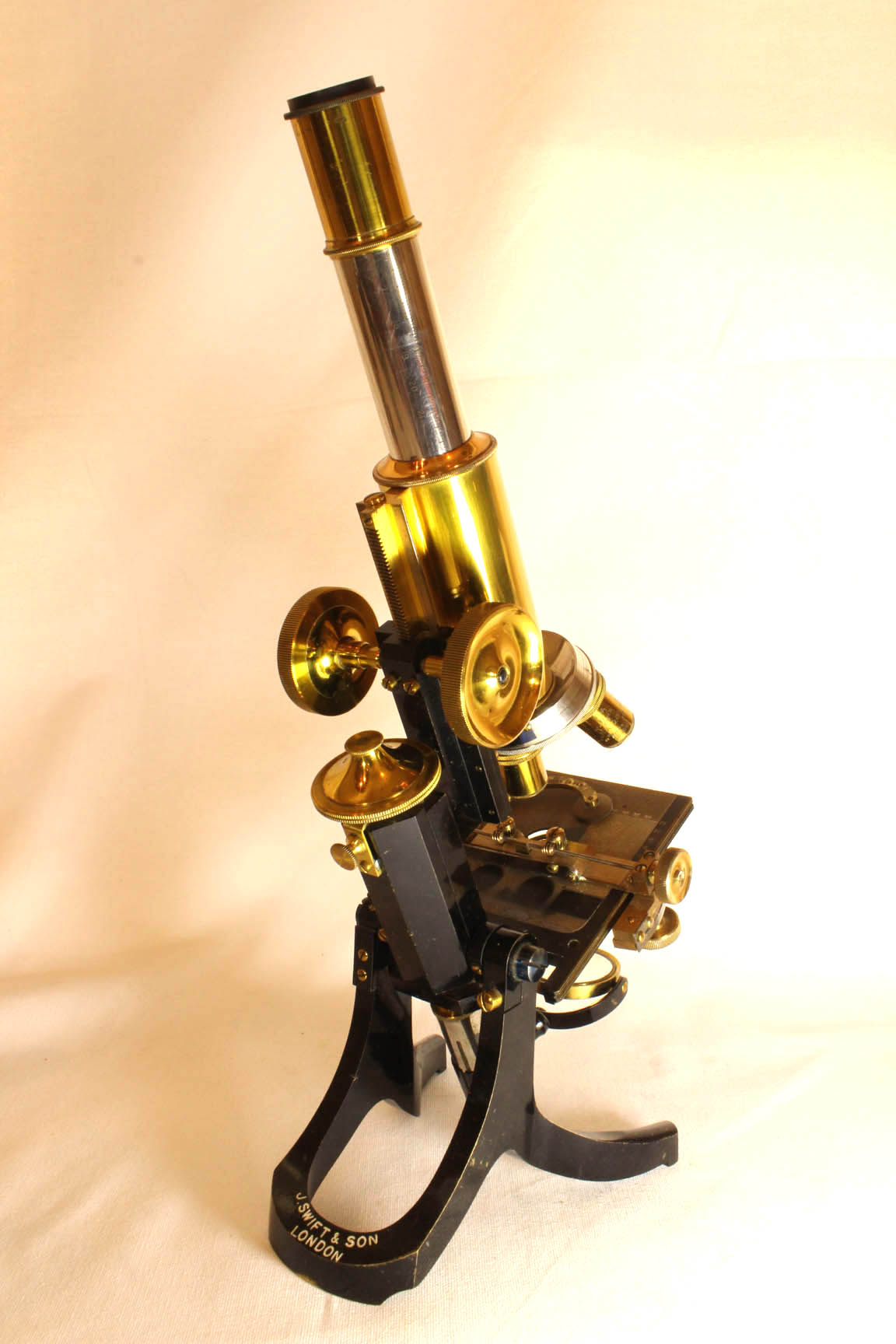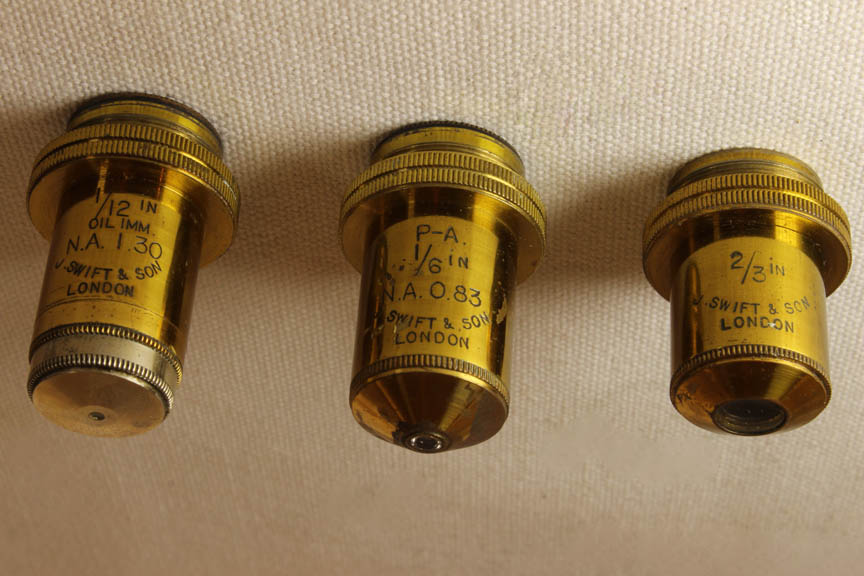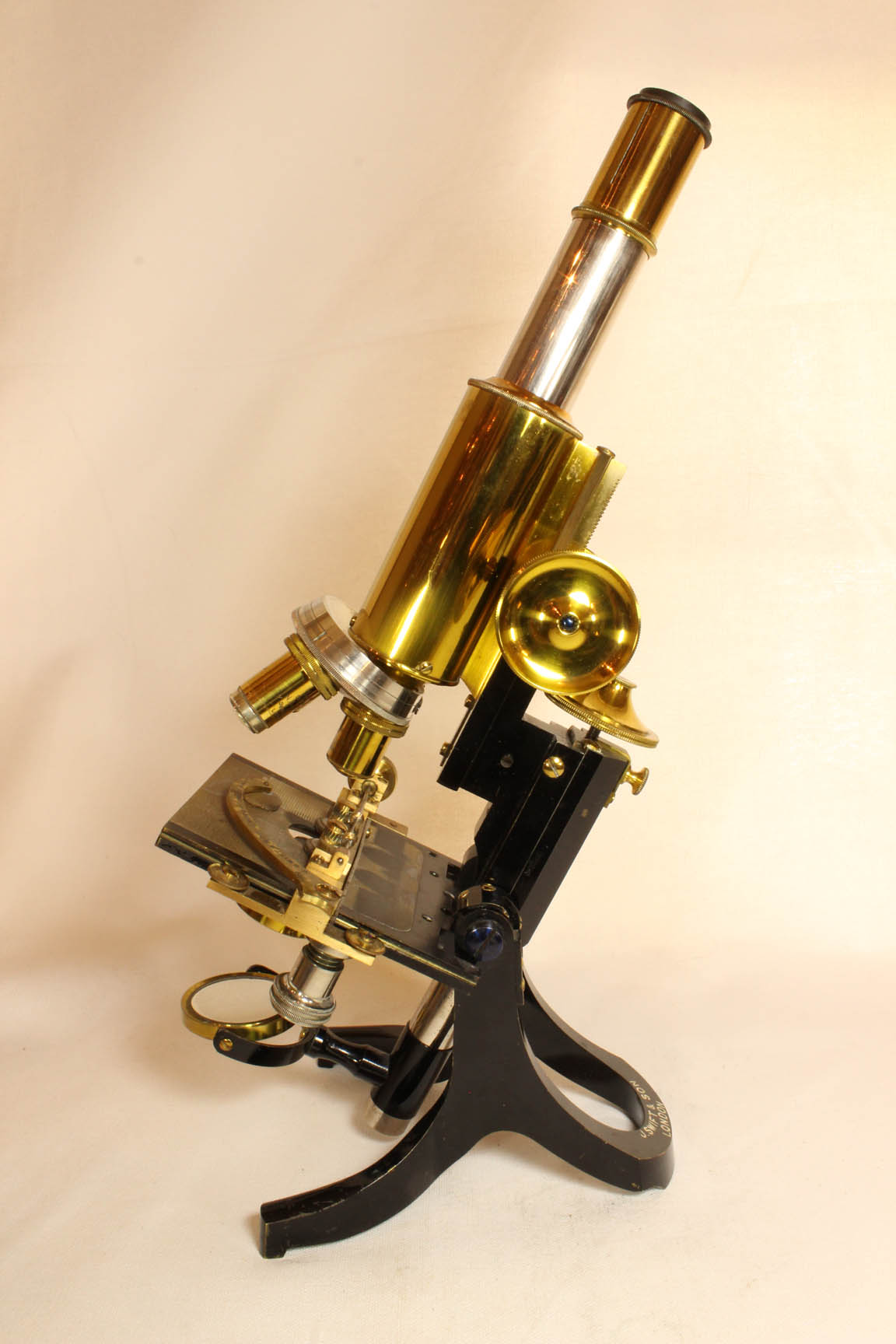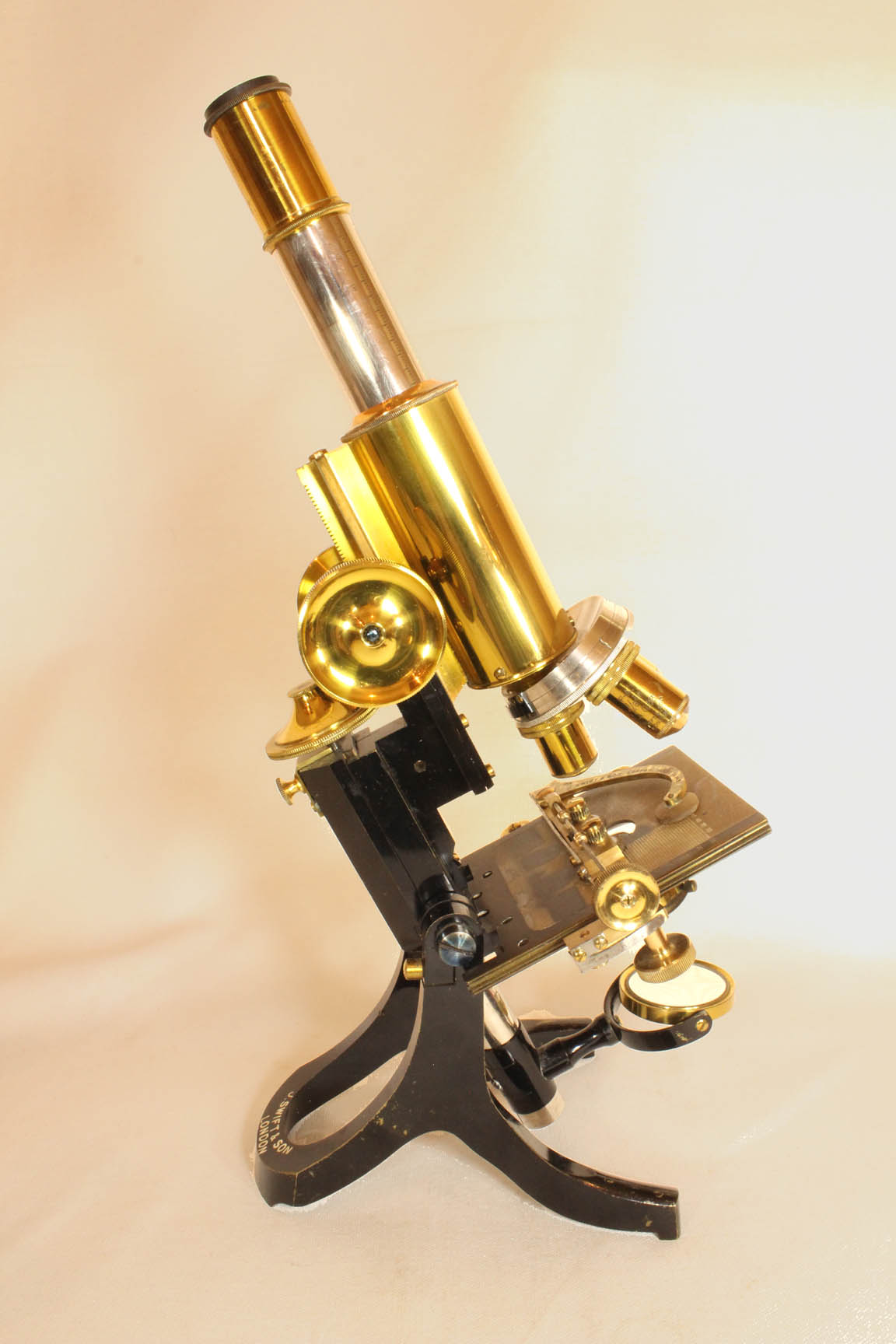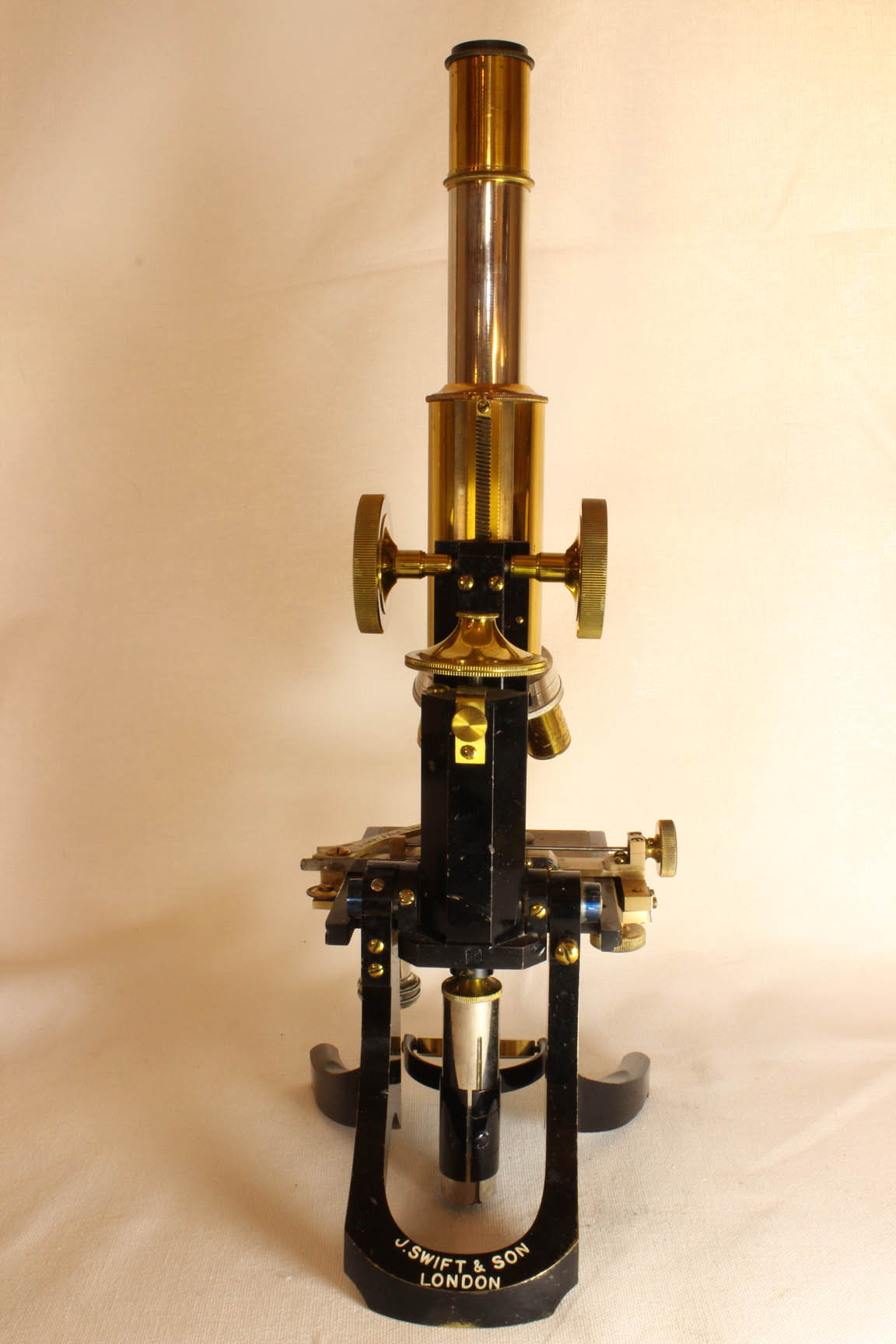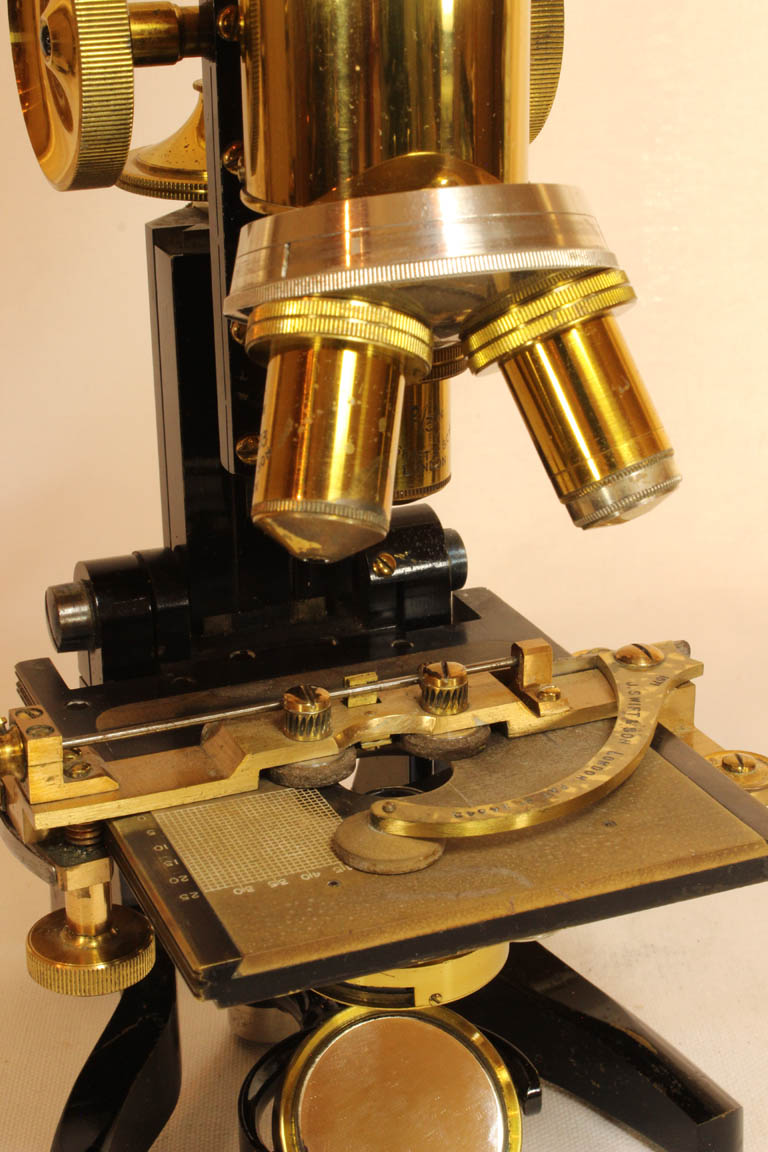MICROSCOPE-ANTIQUES.COM © 2013-21.
MAKER: JAMES SWIFT & SON
MODEL: 'BACTERIOLOGICAL' MICROSCOPE WITH OPTIONAL TRAVIS 'ROLLER STAGE'
c. 1902
SIGNED: J. SWIFT & SON, LONDON
SERIAL NUMBER: 11200
Please Click On Any Picture for a Larger Version
DESCRIPTION: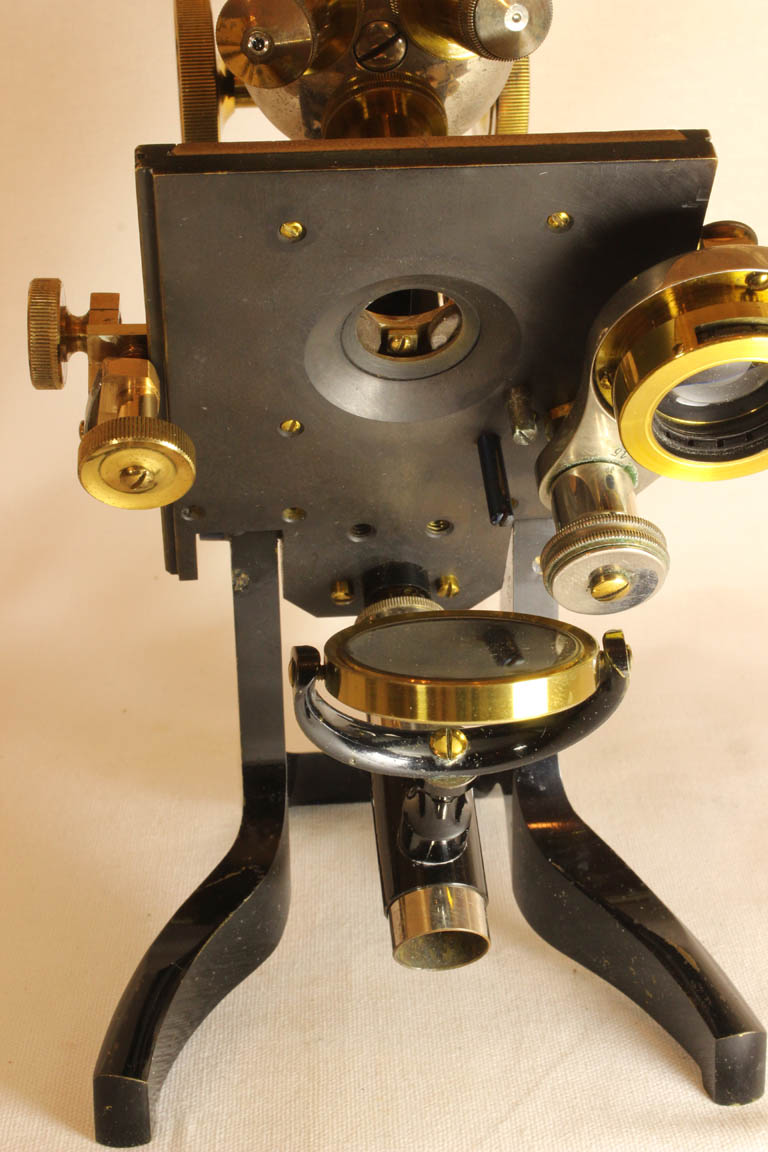 This microscope arises on an an 'English' or 'Crouch' foot with a U-shape in the rear forming the third toe of a tripod. It is signed on the bottom of the rear of the foot 'J. SWIFT & SON, LONDON.' The foot and limb have an oxidized brass finish. Course focus is by diagonal rack and spiral pinion, as invented by Swift.
Fine focus is by micrometer screw long lever. The tension on the fine focus screw is adjustable via a small knurled knob projecting backwards on the limb just below the fine focus wheel. The fine focus has a small diameter knurling in the center for fast movement, and the usual larger diameter wheel for finer movements.
The stage is covered with vulcanite (hard rubber) and has a registration scale in the upper right corner just like the 'Histological and Physiological' model in this collection. There are lacquered brass screws for adjusting tension on the inclination joints and also the rack and pinion slide.
The substage mirror is plano and concave and is on a gimbal. The mirror gimbal is attached to a sleeve riding on the chromed tailpiece.
An Abbe condenser with iris diaphragm is focused up or down by spiral screw and can be turned aside out of the optical axis when in its lowest position.
There are three Swift objectives, being of 2/3, 1/6, and 1/12 inch focal lengths, the latter an oil immersion. The n.a. is 1.30 for the 1/12 inch, and 0.83 for the 1/6 objectives.
This microscope arises on an an 'English' or 'Crouch' foot with a U-shape in the rear forming the third toe of a tripod. It is signed on the bottom of the rear of the foot 'J. SWIFT & SON, LONDON.' The foot and limb have an oxidized brass finish. Course focus is by diagonal rack and spiral pinion, as invented by Swift.
Fine focus is by micrometer screw long lever. The tension on the fine focus screw is adjustable via a small knurled knob projecting backwards on the limb just below the fine focus wheel. The fine focus has a small diameter knurling in the center for fast movement, and the usual larger diameter wheel for finer movements.
The stage is covered with vulcanite (hard rubber) and has a registration scale in the upper right corner just like the 'Histological and Physiological' model in this collection. There are lacquered brass screws for adjusting tension on the inclination joints and also the rack and pinion slide.
The substage mirror is plano and concave and is on a gimbal. The mirror gimbal is attached to a sleeve riding on the chromed tailpiece.
An Abbe condenser with iris diaphragm is focused up or down by spiral screw and can be turned aside out of the optical axis when in its lowest position.
There are three Swift objectives, being of 2/3, 1/6, and 1/12 inch focal lengths, the latter an oil immersion. The n.a. is 1.30 for the 1/12 inch, and 0.83 for the 1/6 objectives.
This microscope is equipped with a Travis mechanical 'Roller Stage'. The device rides on wheels in grooves machined into the right and left edges of the stage. On the left side there is a single thin groove; on the right there is a double groove. The Travis attachment has two wheels with thin tapering edges on the left side, and a small diameter double-grooved wheel on the right controlled by a knurled knob. The box holding the double grooved wheel is hinged to the rest of the attachment and the this small wheel is held firmly against its track by a strong spring. This supplies the 'vertical' or X-axis motion to the slide. 'Horizontal' or Y-axis motion is accomplished by 2 vulcanite wheels in direct contact with the edge of the slide closest to the limb, while the upper edge is pressed towards those two wheels by a third vulcanite wheel on a sprung arm. The driving wheels have pinions driven by worm screws both attached to a single thin axle driven by a knurled knob. This attachment is signed: '1571, J SWIFT & SON LONDON PATENT 24345. The beauty of this attachment is how quickly it can be attached or removed, without any clamps or screws. It requires, of course, the stage already be pre-machined with the grooves.
HISTORY OF THE BACTERIOLOGICAL SWIFT MICROSCOPE AND THE TRAVIS ROLLER STAGE
 The Bacteriological Swift microscope was introduced in its earliest form in 1887 as reported in the JRMS for that year on page 801. The microscope was said be brought out on the suggestion of Professor Dr E. M. Crookshank, a famous bacteriologist. It featured a slotted (and therefore U-shaped) stage, a high-angle Abbe condenser, a glass stage surface and importantly a lever modification of the Bausch & Lomb continental parallel spring fine focus mechanism. It should be noted that this model had a rack and pinion focusing to the substage and glass covering to the stage. The sides of the stage in this original model do not have grooves for accomodating the Roller stage which was invented in 1894.
The Bacteriological Swift microscope was introduced in its earliest form in 1887 as reported in the JRMS for that year on page 801. The microscope was said be brought out on the suggestion of Professor Dr E. M. Crookshank, a famous bacteriologist. It featured a slotted (and therefore U-shaped) stage, a high-angle Abbe condenser, a glass stage surface and importantly a lever modification of the Bausch & Lomb continental parallel spring fine focus mechanism. It should be noted that this model had a rack and pinion focusing to the substage and glass covering to the stage. The sides of the stage in this original model do not have grooves for accomodating the Roller stage which was invented in 1894.
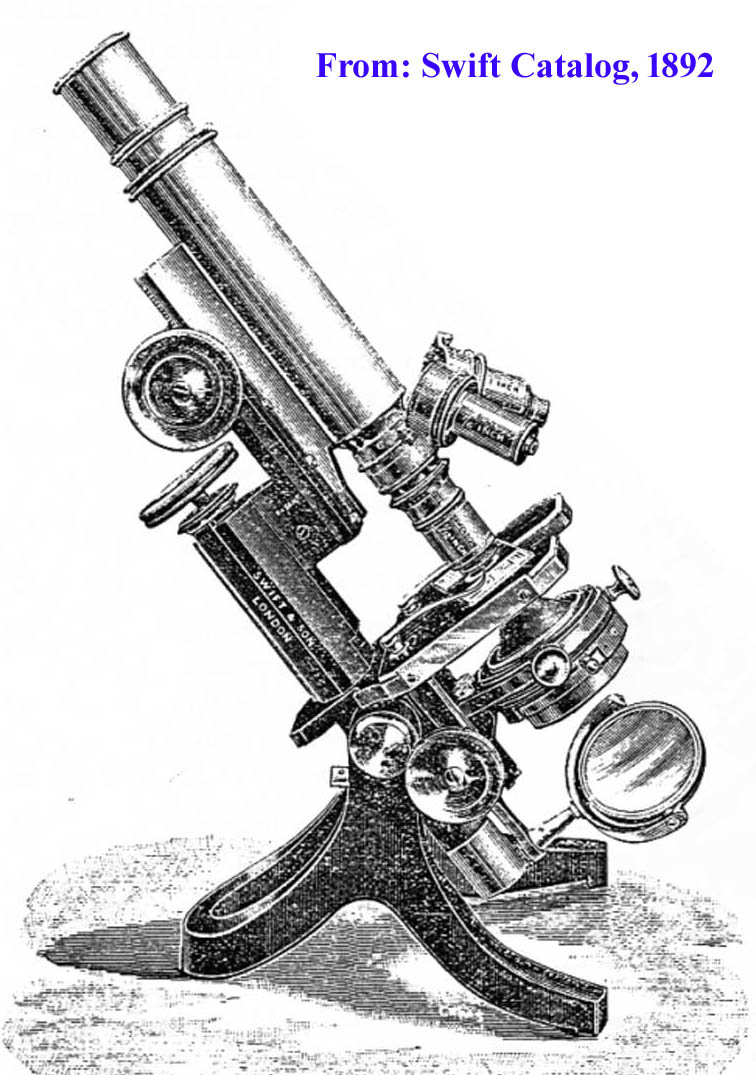 The next model, as shown in the 1892 catalog, was very similar to the 1887 model, but now has flatter fine focus control knob.
The next model, as shown in the 1892 catalog, was very similar to the 1887 model, but now has flatter fine focus control knob.
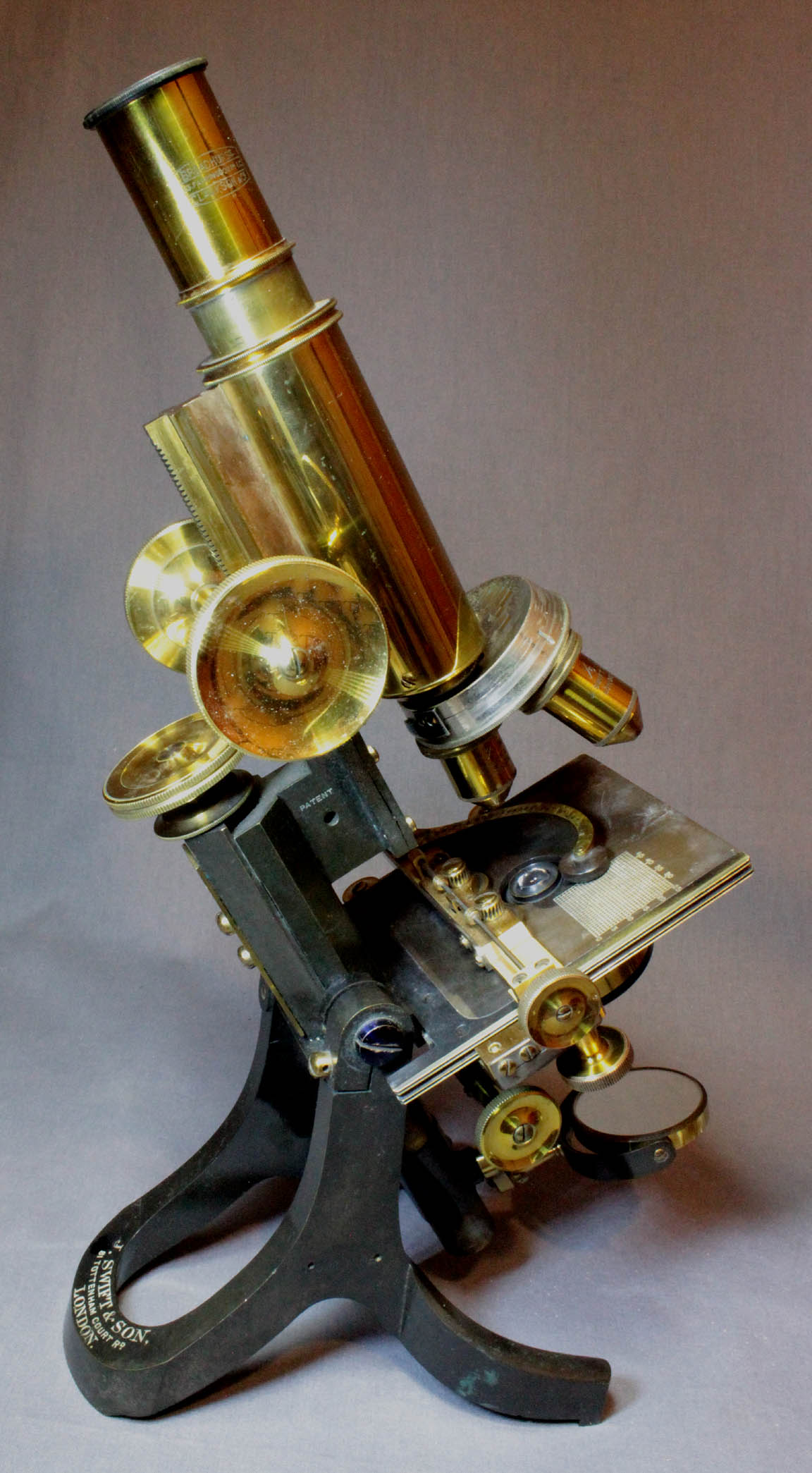 Once the Travis Roller stage was invented in 1894, the Crookshank model had grooves on the side of the stage to accomodate it. The example shown to the left must date to around 1895 as the Roller stage controls were originally on opposite sides of the stage, and this example has both the controls on the same side, a change that took place around 1895. Like the 1892 model, the stage is no longer glass-covered the surface now being covered with hard rubber to maintain warm temperatures, and it is also no longer U-shaped. Note the same flatter design of the fine focus as the previous model. Note that this model has an articulated mirror support whereas the later madel had the mirror attached via a straight piece attached directly to the collar on the tailpiece. This model has a slightly taller foot with the angle of inclination higher than the prior model. The axis of inclination on this example is 5 inches high, as opposed to 4 inches on the prior model, (and also subsequent models, with the exception of the Army model described in the next paragraph). To see a height comparison of this model with the 1904 model see the Bacteriological comparison page.
Once the Travis Roller stage was invented in 1894, the Crookshank model had grooves on the side of the stage to accomodate it. The example shown to the left must date to around 1895 as the Roller stage controls were originally on opposite sides of the stage, and this example has both the controls on the same side, a change that took place around 1895. Like the 1892 model, the stage is no longer glass-covered the surface now being covered with hard rubber to maintain warm temperatures, and it is also no longer U-shaped. Note the same flatter design of the fine focus as the previous model. Note that this model has an articulated mirror support whereas the later madel had the mirror attached via a straight piece attached directly to the collar on the tailpiece. This model has a slightly taller foot with the angle of inclination higher than the prior model. The axis of inclination on this example is 5 inches high, as opposed to 4 inches on the prior model, (and also subsequent models, with the exception of the Army model described in the next paragraph). To see a height comparison of this model with the 1904 model see the Bacteriological comparison page.
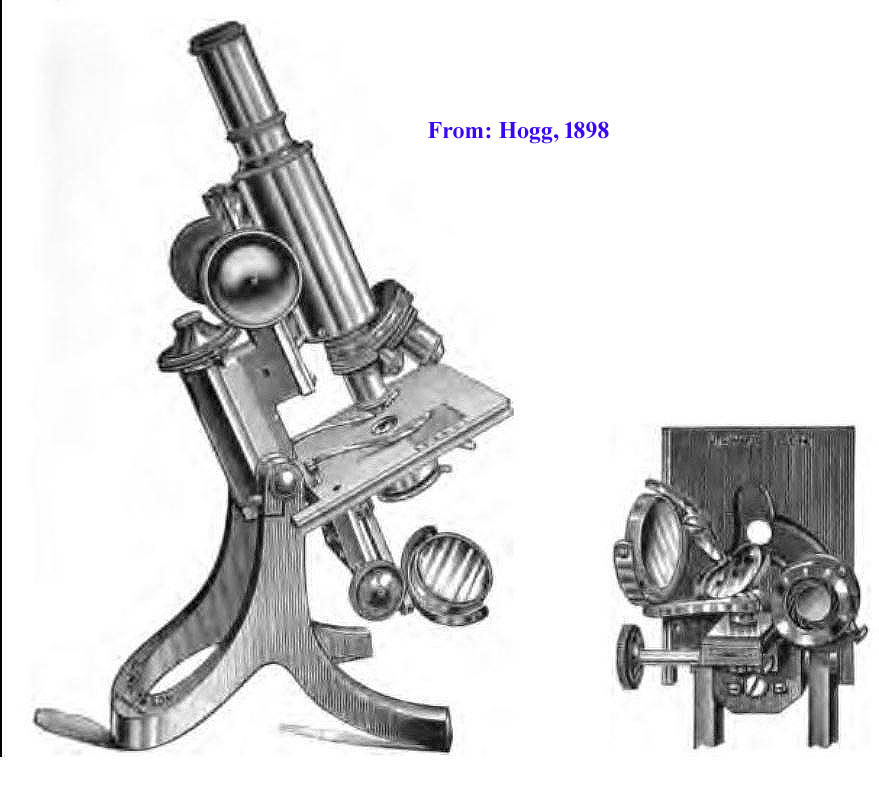 By 1898, Swift was advertising their
By 1898, Swift was advertising their Army Bacteriological Microscope
. This microscope, at first glance closely resembling the Crookshank models, had a stage without a front cutout. It maintained the higher inclination joint at 5 inches. It also had rack and pinion substage with the ability to put the condenser out of the optical axis while at the same time, keeping the substage focus at the same level, allowing convenient and rapid switching between the two configurations, maintaining the same focus of the condenser when it was swung back into the optical axis. This was a feature suggested by Professor Wright of the Army Medical School for bacterial work. A quadrant of apertures was also provided with stops to provide oblique illumination for use when selecting colonies of bacteria from a culture for mounting. By 1902, the supplementary diaphragm was apparently no longer included, the facility to throw the substage out of the optical axis without changing its focus being the difference between this and the model described in the next paragraph. This model, like the original Crookshank model, once again included a thicker fine focus knob with a smaller upper diameter knurling for faster rotation. This type of knob is found on all the subsequent Bacteriological models.
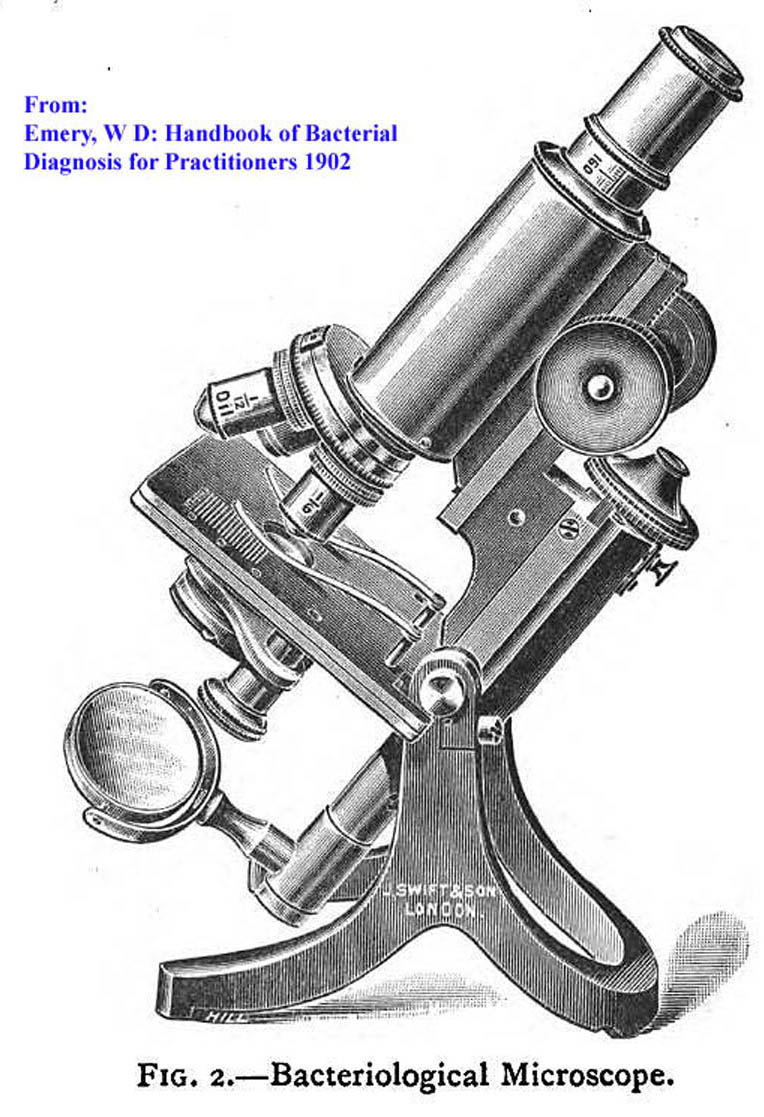 By 1901, Swift was advertising this microscope as seen here with a solid stage, covered in hard rubber, the purpose of which was to keep warm subjects from cooling off too quickly. The inclination joint was again slighty lower. The substage fine focus was changed to the (less expensive) type seen on this and many other microscopes during this time period and for a long time afterward. As shown in an advertisement of 1902, this version, with the inclination joint only 4 inches above the surface, was sold at the same time as the more sophisticated
By 1901, Swift was advertising this microscope as seen here with a solid stage, covered in hard rubber, the purpose of which was to keep warm subjects from cooling off too quickly. The inclination joint was again slighty lower. The substage fine focus was changed to the (less expensive) type seen on this and many other microscopes during this time period and for a long time afterward. As shown in an advertisement of 1902, this version, with the inclination joint only 4 inches above the surface, was sold at the same time as the more sophisticated Army
model described in the previous paragraph which maintained the higher inclination joint. The type of vertical screw fine adjustment seen on this microscope was popular among German and American Makers for many years afterwards. An engraving of the Bacterial microscope appeared in Emery's 'Handbook of Bacterial Diagnosis for Practioners' of 1902. You will note that this is the exact model pictured on this web page, even including the triple nosepiece changer.
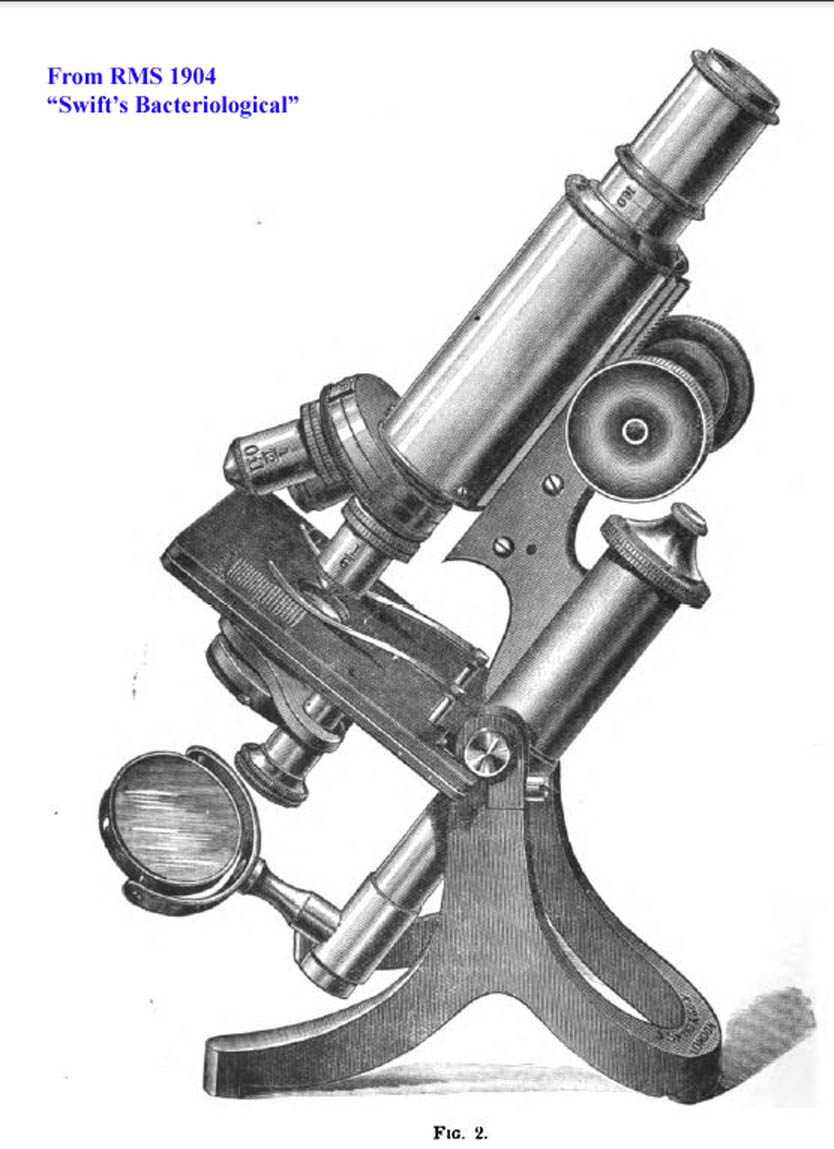 By 1904, the design was again altered, as it was on some other Swift stands, most notably the 'Discovery' model, to incorporate a simpler and cheaper continental style fine focus. The stand was otherwise the same.
By 1904, the design was again altered, as it was on some other Swift stands, most notably the 'Discovery' model, to incorporate a simpler and cheaper continental style fine focus. The stand was otherwise the same.
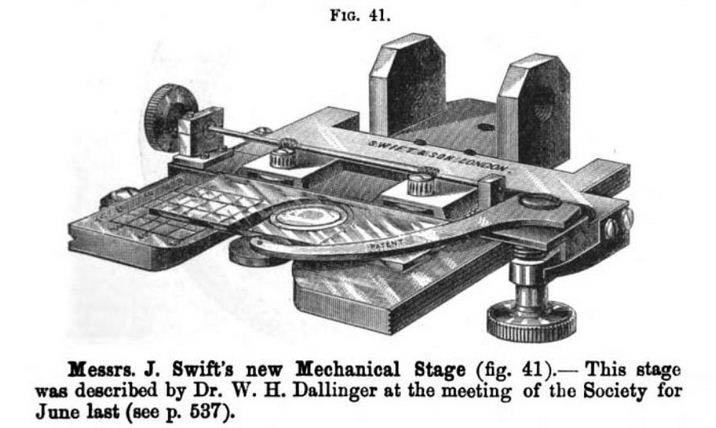 This microscope is equipped with a Traviss mechanical 'Roller Stage'. This easily attached accessory was invented in 1894 by Will R. Traviss, a Swift employee who became foreman. Traviss is famous not only for this stage attachment, but also for his later invention, the 'expanding stop' for dark ground illumination. Although the original design of the roller stage had the two knobs on opposite sides of the stage, this was quickly changed to having the arrangement as shown on this instrument, with both knobs on the same side, thus allowing one hand free to adjust the focus, etc.
This microscope is equipped with a Traviss mechanical 'Roller Stage'. This easily attached accessory was invented in 1894 by Will R. Traviss, a Swift employee who became foreman. Traviss is famous not only for this stage attachment, but also for his later invention, the 'expanding stop' for dark ground illumination. Although the original design of the roller stage had the two knobs on opposite sides of the stage, this was quickly changed to having the arrangement as shown on this instrument, with both knobs on the same side, thus allowing one hand free to adjust the focus, etc.
